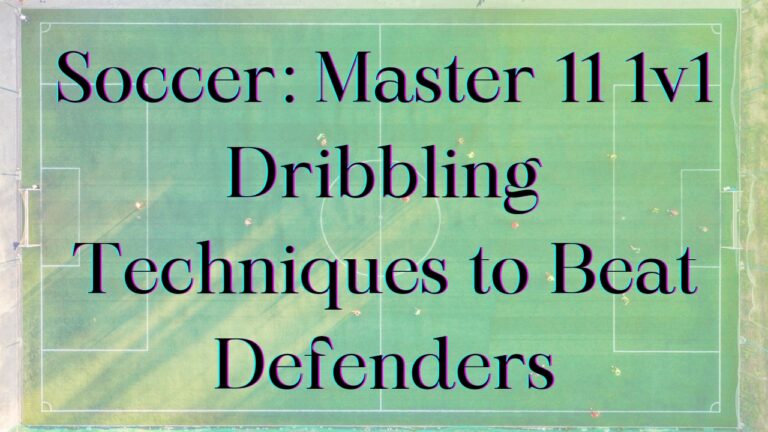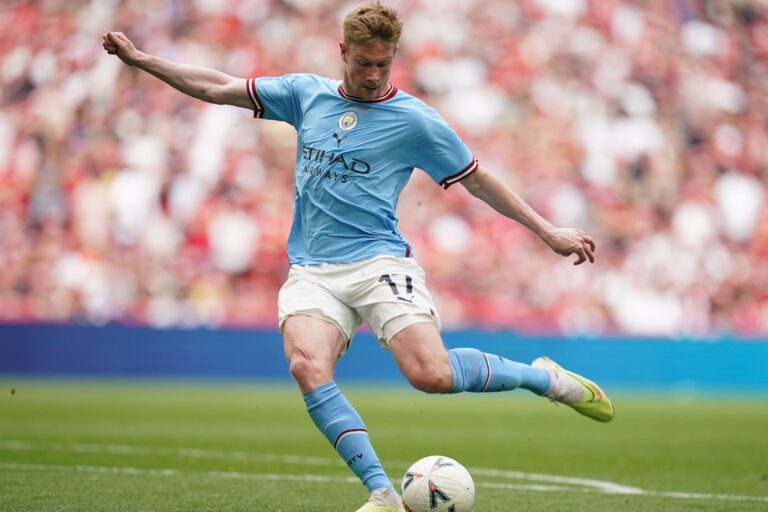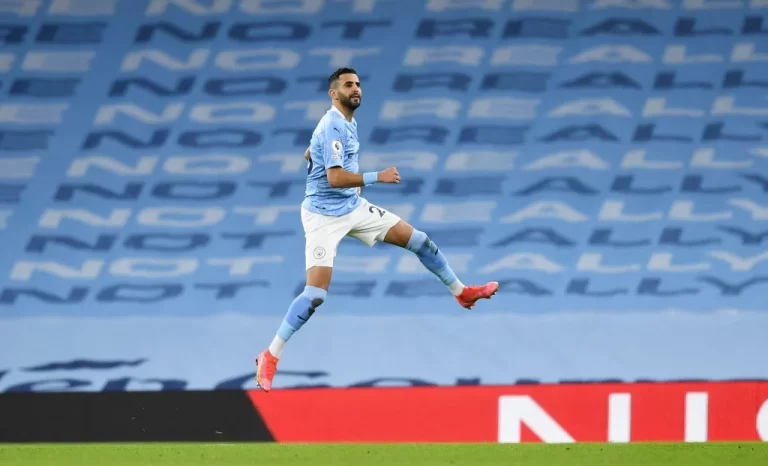Space is the lifeblood of soccer. Matches are often won and lost based on which team can exploit space in the attacking third. This is especially true for midfielders, who operate in the critical spaces between the defensive and offensive lines. The ability to create space as a midfielder is an invaluable skill that separates the best from the rest.
Why Creating Space is Crucial for Midfielders
Midfielders serve as the connectors between defense and attack. They must link play, transition possession from back to front, and supply penetrating passes to the forwards. To perform these duties effectively, midfielders must find and generate space in tight areas. Without space, a midfielder’s options are limited, and progression up the field is slowed.
Here are some of the key reasons why space creation is so vital for midfielders:
Control tempo of the game: When midfielders have space, they can determine the pace of play. They can speed up attacks or slow down the game by keeping possession. Without space, they are forced into quicker, riskier decisions.
Receive passes cleanly: Midfielders need space to provide a safe passing outlet. When tightly marked, there is a greater risk of interception or tackles when receiving passes. Space allows for cleaner reception and easier distribution.
Turn and assess options: After receiving a pass, space gives midfielders time to turn and evaluate the field. This allows them to maintain possession or pick out incisive forward passes.
Dribble forward: Space enables midfielders to carry the ball forward through the thirds of the field. Beating the initial defender with space allows momentum into the attack.
Supply key passes: The final pass that sets up a chance relies on space. Midfielders can play killer through balls, crosses, and defense-splitting passes when space opens up.
As you can see, almost everything a midfielder must do revolves around having adequate space. When operating in a congested midfield, creativity, and technical excellence are required to manufacture pockets of space.
Off-the-Ball Movement to Create Space
Intelligent off-the-ball movement is one of the primary ways midfielders can create space to receive passes. Even when closely marked, many types of runs and movements can lose a defender:
Check away: Make a quick diagonal run away from the ball to create separation from your marker. Checking away often opens space in behind to then check back toward the ball.
Vary speed: Accelerate, decelerate, and use bursts of speed to get a step on your defender. Changing pace frequently keeps them off balance.
Diagonal runs: Angled runs are more effective than linear runs to create space. Diagonal runs force the defender to turn hips, opening gaps.
Lateral runs: Runs across the field away from the ball move defenders and open passing lanes through the newly vacated space.
Backward runs: Checking back away from the goal takes advantage of defenders who overcommit. This allows you to turn and face forward in space.
Blindside runs: After passing the ball, make a curved run behind the defender’s back to receive a return pass in space.
Spin-off defenders: Use body feints or quick spins to lose your marker who overcommits in one direction.
Drift into pockets of space: Scan the field as you move to identify undefended pockets of space to drift away from defenders.
The key is varying your movement so defenders cannot predict where you are going next. Explode into space when it opens up to maximize separation.
Use Teammates to Create Space
Creating space as a midfielder is not just an individual endeavor. You can work with teammates to drag defenders out of position and open up space to exploit. Some effective team tactics include:
Wall passes: Pass to a teammate and make a timed run around the defender as the ball is returned to you in space. This pass-back move is ideal against man-marking.
Decoy runs: Make runs that occupy your defender but do not look for the ball. This drags defenders out of position and creates openings for teammates.
One-twos: Quick give-and-go exchanges where you immediately return the ball to a teammate after the initial pass. The rapid 1-2 combinations allow you to get in behind the defense.
Overlaps: Having the wide fullbacks or wingers make overlapping runs down the flanks pulls defenders wide opening the middle.
Forward rotations: Rotating positions with a forward briefly can create uncertainty for defenders if done smoothly. This can open space to receive a pass as you return to the midfield line.
The key is developing an intuitive understanding with your teammates. Movements should be coordinated to manipulate specific defenders based on their tendencies. The ultimate goal is creating passing angles to receive in pockets of space.
Ball Control and Skills to Create Space
No matter how clever your off-ball movement is, you still need the technique to control the ball and beat defenders in tight spaces when receiving passes. High-level ball control skills allow midfielders to create space for themselves or teammates in congested areas.
Close control The ability to get very close to the ball and move it rapidly with small, precise touches to keep it close. This allows maneuvering out of pressure in tight spaces.
Feints and stepovers: Quick body and foot fakes to shift weight one way before exiting the other. Defenders are unbalanced allowing you space to explode into.
Accelerations: Bursting forward with pace after beating a defender creates separation. Changing gears rapidly once space opens up is key.
Chips/lobs: Well-placed lobs over a defender’s head or a crowded midfield line can create openings to run onto the ball.
Shoulder drops: Dropping a shoulder one way sells the defender before exiting the opposite direction into space.
Scissors: Wrapping one foot behind the other rapidly allows a quick change of direction to beat defenders.
Pivots and spins: Quickly rolling the ball behind your standing leg or spinning away from pressure creates time and space on the ball.
Having the full repertoire of ball control moves gives you solutions to beat defenders 1v1 when receiving passes in tight spaces as a midfielder.
Create Space off the Dribble
Midfielders cannot rely solely on receiving passes to generate space. Effective midfielders are also adept at creating space by dribbling at defenders. Taking defenders on 1v1 or even 1v2 forces them to commit and opens space.
Here are some key tactics to create space off the dribble:
Change of pace: Accelerating or slowing down abruptly during a dribble forces defenders to adjust and unbalances them. Explode into the new space this creates.
Change of direction: Faking one way before sharply changing direction gives defenders no chance to recover if timed correctly.
Drive at space: Identify gaps between defenders and directly attack the open space to force them to commit or backpedal.
Bursts of acceleration: Hitting top speed for several yards can allow you to blow past defenders before they react.
Head/eyes up Dribbling with your head up allows you to identify space as it opens up and attack it immediately.
Feints and skills: Use an array of foot and body feints during dribbles to unbalance defenders and cut into space.
Takeovers: When dribbling at pace, move the ball seamlessly between feet to get defenders off balance.
The key is decisiveness – as soon as space opens up, instantly accelerate into the gap before defenders can recover their shape. This will require scanning the field while dribbling to spot defender reactions.
Conclusion
Creating space as a midfielder is an essential attribute at the higher levels of the game. Midfielders who can manufacture pockets of space give their team a huge advantage in controlling matches.
The key takeaways around creating space as a midfielder are:
– Master intelligent off-ball movements such as checking, angled runs, and drifting into space. Be unpredictable.
– Collaborate with teammates using wall passes, overlaps, rotations, and decoy runs. Coordinate movements.
– Develop close control and skills to beat defenders 1v1 in tight areas. Accelerate into space.
– Attack space off the dribble by reading defender reactions and bursting into gaps as they open up.
– Maintain constant awareness of space on the field and have the vision to see openings as they emerge.
While natural ability plays a role, creating space ultimately comes down to smart decision-making, timed movements, quick reactions, and composure on the ball. Mastering these skills will make you a midfield force.
Related Post: How to Train as a Football Midfielder to Dominate the Pitch




